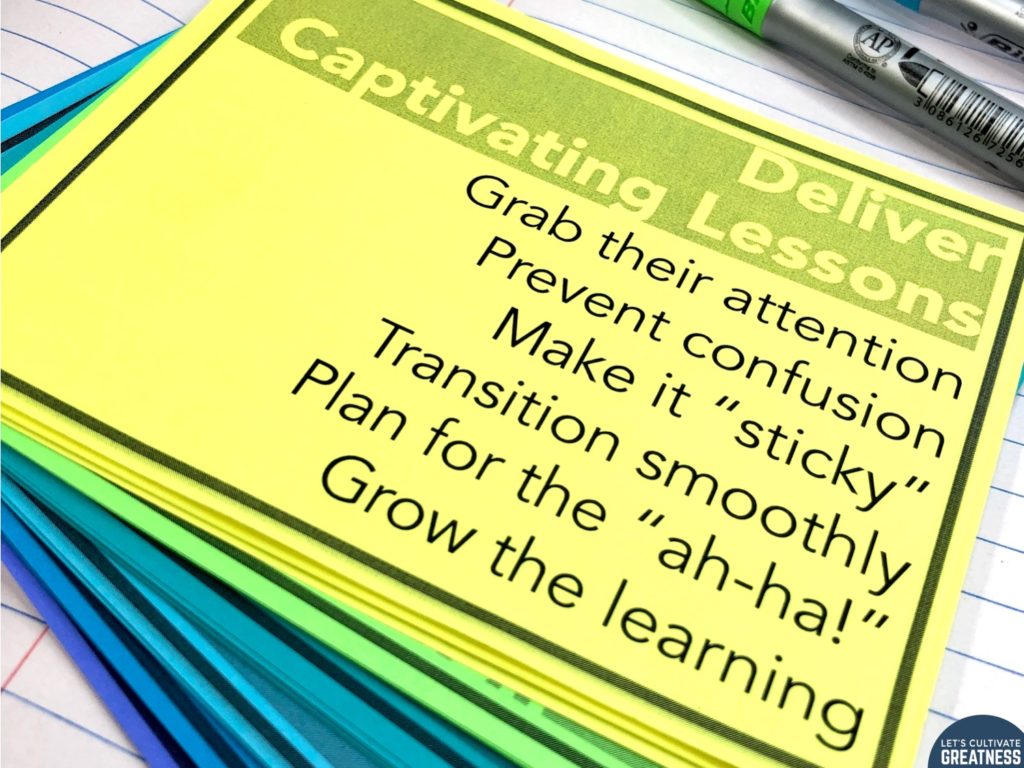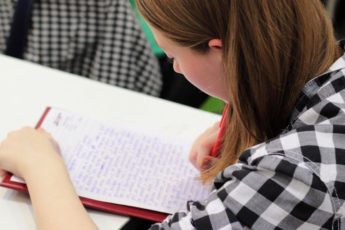Teaching high schoolers is an intimidating beast.
There, I said it, because it doesn’t do anyone any good to keep that truth unspoken.
But it’s also a ton of fun and a bit addicting. Especially when you realize you just captivated 35 goofy teenagers for an hour with a topic they would otherwise think is boring.
So whether you are just starting your student teaching practicum and looking for a few foundational instructional strategies, or you’re a long-time teacher needing a mid-year refresh, you’ll want to incorporate this list of my favorite start-using-tomorrow strategies.
The magic of teaching lays in perfecting a core toolbox of effective teaching strategies that are based on real brain science about how the human mind understands. The first thing to know about impactful instruction is that no matter whether your class periods are 45 or 85 minutes long, there is a beginning, a middle, and an end with transitions in between.
It’s really just like a story. You are telling a story. An impassioned one. One in which your students are the heroes.
The most powerful storytellers follow a precise formula that the audience never notices, but is always there. Ask any aspiring novelist or motivational speaker.
How I approach the hour or so I have each day with my students changed dramatically after I read Chip and Dan Heath’s book Made to Stick (seriously, one of my top 5 books of all time) and after TED Talks began blowing up as THE model for captivating public speaking. Years after my Master’s program ended and I was still struggling to elevate my lessons beyond “Today we are going to…,” these helped show me real strategies for engaging the toughest audience of all—teenagers.
These strategies follow a deliberate arch that will carry you through your lesson, from the hook to the ah-ha. I don’t think I’ll ever teach a social studies method course, so instead I’ve chosen this space to share my 12 all-time best strategies that I use in my high school social studies classes on the regular.
If you want more, my 48 instructional strategy favorites are organized into the 6 stages of the perfect lesson and formatted into a life-saving flip deck of 48 cards that you can keep handy at your desk when planning. I use it all the time because, to be honest, I originally made it for myself!

#1 The Hook
We all know a hook is important in teaching the 5-paragraph essay, but what about in the opening minutes of class?
What if you started immediately with a hook, created a bit of a cliff hanger, then tasked your students with a challenge, all within the first few minutes? Then, while they are working away, you handle all those things that otherwise kill the momentum before class has even started: attendance, missing pencils, or questions about yesterday’s lesson.
My three favorite hooks aren’t novel, but rather the exact same ones as those on the tried-and-true, science-backed list we give our students when teaching about the introduction paragraph.
Offer a crazy statistic or fact.
I start the very first day of my World Population unit asking students to spend a couple minutes guessing the percentage of people in the world who live under $2 a day and then $5 a day. They are floored when I reveal the answer—about 10% and 50%, respectively, according to the World Bank.
Tell a story.
The day I introduce our interview narrative project component of my Three Branches of Government unit, I tell the story of my neighbor who, while serving during the Vietnam War, gained a whole new appreciation for the meaning of democracy as he was perched high above his two thousand Naval shipmates and tasked with fixing the radar equipment while the whole mission waited on him.
I haven’t said a word yet about the interview project they will be conducting in the coming days and they have no idea yet why I’m telling this story, but they are on the edge of their seats. And, honestly, it very likely is in part because they think my story is a tangent from the day’s regular lesson. Little do they know…
Read all about creating your own interview project in my post where I break it down into 5 easy steps!
Display an “onion image.”
As a history teacher, I delight in this one because our discipline is so rich with images that offer a bit of a puzzle. What’s going on? Where is this? What are they doing? Why are they doing that? What does that detail mean? What are they likely thinking?
We are visual creatures and images are accessible regardless of reading levels. Images as hooks are a must! Pick a photograph or piece of art that has multiple things going on, comes at a very specific moment in history, or is perfectly representative of the topic you are covering today in class. You can read more about this in my post where I detail my favorite image analysis strategy.
#2 The Directions
You will save so much of your sanity and precious class time if you deliver your directions in a way that students actually hear and do them. This is probably the most fundamental aspect of teaching to master first, especially if you feel overwhelmed by all these other tips. Often these kinds of types are strategies are labeled for ELL instruction and we forget that all brains need needs clear, easy-to-follow directions!
Give one at a time.
This one works great if you need students to complete a series of tasks that require a specific order, like folding a piece of paper and labeling it before watching a documentary.
State the first direction, modeling it yourself if at all possible, and wait until everyone has done it before moving onto the next step.
Fold your paper hot-dog style like mine… Now, label the left side… Then, divide the right side into two…
Number the steps.
Tell students how many total steps, parts, or sections there are in the upcoming activity so that students have a broader understanding of what they are doing. Until they know the big picture, the details are meaningless. As you number them, hold up your fingers for visual reinforcement. This works great when you are about to release the students for independent work. Bonus strategy: you’ll also want to have the steps posted on the board or student worksheet during the activity.
At each station, you will need to do three things. First…
Assign a task.
For every single text, video, image, or other stimulus, give a specific task that requires physical action. It may seem obvious why you want students to read a news article, but they won’t know it for sure unless you tell them, and they won’t do it for sure unless you task them. It can be any sort of task, just make it simple.
As you read, highlight with your two colors for problems and solutions….
As you examine each photo, write an emotion in the margin that…
As you watch, list the 6 causes…
#3 The Lesson
This is what separates teacher overwhelm from teacher confidence. Doing deliberate things as part of a normal lesson because it makes the learning stick, whether you students realize it or not. It doesn’t hurt to reveal your tricks from time to time, especially when the energy in the room is waning.
Write it down.
Writing is thinking. And by writing, I mean handwriting. So much scientific data is revealing now what teachers would file under #obvious, but it’s still worth mentioning because writing is more than what we as teachers often think. Writing can be as small as a single word or even symbols.
Task students to summarize each paragraph of a historical essay into a single word in the margins as they read. Challenge students to assign a big, bold letter grade on the top of the text to the State of the Union Address after analyzing it. Recap with students the purpose of a political cartoon the following day by having them commit a verb next to the image.
Get them up.
This is the strategy we often need to be reminded of, because we are the ones up and moving around all day. Jennifer, over on Cult of Pedagogy, details a long, fantastic list of science-backed movement activity ideas so I’ll just describe two super easy ones you can implement on the spot.
Have students pick a YES or NO side of the room to force them to decide a position, or pick a corner assigned as ABSOLUTELY YES, SOMEWHAT YES, SOMEWHAT NO, and ABSOLUTELY NO (or some similar variation).
Another effective one is having students get up and find a new partner every couple of minutes to complete one more step of an activity. That way students get to work through their task hearing different ideas. Keep the switching time short—no more than 10 seconds!
Have a driving question.
Know the big picture for why you want students to know something so well that you not only share it, but challenge students to it at the beginning, at the closing, and at any time when a student is lost. And this something has to be more authentic than “… because it’s a state standard.”
Having an open-ended question that sparks curiosity or truly asks students for their thoughts is a sure-fire way to build an engaged classroom. You can use a question to frame a whole unit or just a single lesson.
If you want to know more about crafting units and lessons around driving questions, I detail it in this blog post all about creating a PBL classroom. Don’t worry, though, you can still have great driving questions without going full PBL.
#4 The Next Level
It’s one thing to go through the motions of a lesson and get words written down on worksheets, it’s an entirely different thing to create ah-ha, connection, and takeaway. These next few are the strategies for you, my teacher friends, who are feeling like you have Marzano’s basic strategies on lockdown and are ready for the next step.
Facilitate divergent thinking.
This is one of my favorite parts of being a social studies teacher. We are the teachers who get to challenge students to think beyond what the “right” answers are. We get to ask questions with no “right” answers at all!
Ask students to think of the opposite. Why wouldn’t someone…
Ask students to find evidence for the other side of their position. On which aspect can you agree…
Ask students for an alternative. If she had chosen another tone for her speech…
Teach meta-analysis.
Never analyze a source for its content alone. Have students also consider the persuasive devices used, the tone that is developed, the organizational structure chosen. If you want your students to be independent thinkers and, more importantly, doers, then you have to show them the tricks to being effective communicators and citizens through the models of past successes!
Don’t just show students photos of the 1960s lunch-counter sit-ins, but also have them decide how effective sitting-in is as a protest strategy. (I have a great DBQ mini-unit that does just this!)
Don’t just have students read the arguments of Mary Lease, the Knight of Labor, and the Populist Party for how broken Gilded Age government was, but also have them decide what about their arguments and examples were so persuasive that they sparked real change. Check out my Gilded Age source 6-pack to see what I mean.
Connect to today.
As social studies teachers, we try our best to consume high-quality media, but still it’s impossible to always be on top of each day’s news cycle. So, give yourself grace, for sure, but also be selective about a few main sources that come in formats you can consume easily. Having even a small pulse on the news affords you so many opportunities to weave in and make connections to what you are teaching in your lessons. And I always find taking a minute or two of class time to make that connection is well worth it in deepening student learning.A lot of news organizations now have daily emails or podcasts that take just minutes to absorb. NPR’s Up First promises to be around 10 minutes and the New York Times’ The Daily is around 20 minutes. Sign up for Washington Post’s newsletters for quick emails on specific political issues as well general headlines.
The Atlantic has great long-form articles on all sorts of social, political, and economic issues that can be read at a more leisurely pace over the course of a month. I have learned I just can’t keep up with weekly news magazines, so a monthly one has worked well for me.
If you want a quick skim of the day’s news from across the political spectrum, then AllSides is the perfect website for you (and one you’ll likely want your students to explore!). For certain issues, I head straight here to ensure I am hearing different angles. It’s very eye-opening!
I hope these strategies give you the starting point or reboot you need to be an even more awesome teacher!
Click below to grab my complete 48-card Instructional Strategies flip deck for more great strategies in one easy reference tool!










